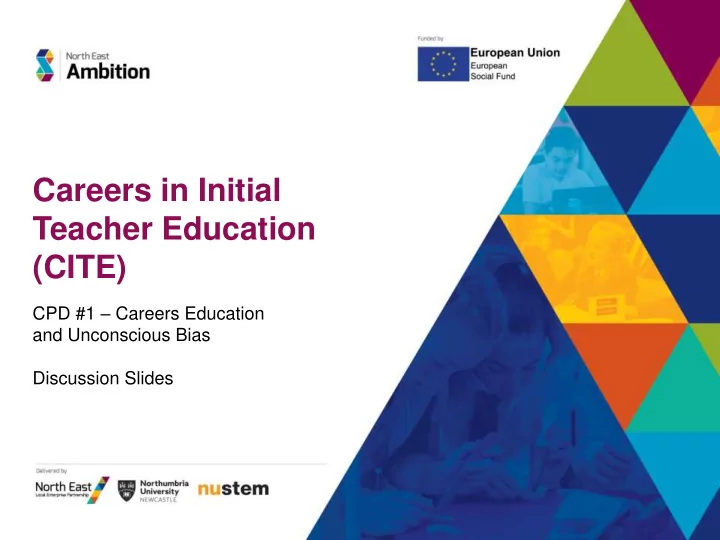

Careers in Initial Teacher Education (CITE) CPD #1 – Careers Education and Unconscious Bias Discussion Slides
Introduction These slides contain discussion prompts that we will use during the presentation.
Discussion Break 1 The next 3 slides show: • information about a ‘class of thirty’ which shows how the (pre -covid) job market would look if it were represented by a primary school class. • The ‘class of thirty’ split by gender • A-level entries to a range of subjects split by gender. Discussion questions: What do you notice about the data on the slides? Are you surprised by this? Be prepared to feed back your key discussion points in 8 minutes.
A class of 30 children in employment Not in employment Employed in non-STEM fields Employed in STEM fields
30 children in employment (by gender) Not in employment Employed in non-STEM fields Employed in STEM fields Boys Girls
A-Level Exam Entries 2019 by gender
Discussion Break 2 The next slides provide suggestions of six different ways in which bias might affect children’s education in primary. What are your thoughts about the statements? Have you seen examples in schools / classrooms? How might these statements link to the data we saw at the start of the session?
1. The pattern of classroom interactions can unintentionally reinforce messages of expected and accepted behaviours. • Boys are more likely to shout out and so get more time • Teacher punishes an entire class for the actions of a minority • Girls are often used as a behaviour management strategy.
2. Ideas about what children are ‘good’ at, and subsequently what paths are open to them are embedded at an early age. • The phrase ‘typical boy writer’ becomes an excuse for low achievement • Extra-curricular clubs conform to gender stereotypes • Children can be selected for extra-curricular activities based upon strengths and confidence
3. Many texts uphold traditional stereotypes. • Non-fiction texts often portray scientists as men in white lab coats, reinforcing the stereotype • Fiction texts: Heroes are usually male. Women and girls often need saving.
4. Teaching materials and displays can reinforce gender stereotypes. • Images used in displays often conform to gender stereotypes. • Presentations and resources can include stereotypes and stereotypical language.
5. There is a surprising amount of sexist language and behaviour used in society and this can be picked up and imitated by young children. • ‘Don’t be such a girl’. • ‘Man up’. • ‘Can I get two strong boys to help carry some books?’
6. Cultural change will only be achieved in all members of the school community are involved, including parents and carers. Text taken from a homework handout. ‘Please find attached some tricky words, works we can’t sound out. … the children will find it very useful to know these words by sight. Try making another set and play pairs, snap or hunt the tricky word around the house. Boys particularly like the latter because it’s physical and competitive especially if you use a timer. See if you can spot tricky words when you’re out and about or when you’re reading books together.’
Session Feedback Please click on this link and complete the feedback survey before we finish the session. https://northumbria.onlinesurveys.ac.uk/cite-cpd1
References Eliasson, N., Sorensen, H., Karlson, K.G., 2016. Teacher-student interaction in contemporary science classrooms: is participation still a question of gender? International Journal of Science Education, 38:10, 1655-1672. Sadker, M. and Sadker, D., 2010. Failing at fairness: How America's schools cheat girls . Simon and Schuster.
Further reading • Banaji, M.R. and Greenwald, A.G., 2016. Blindspot: Hidden biases of good people . Bantam. • Dweck, C., 2012 Mindset. ISBN: 978-1780332000 • Fine, C., 2010. Delusions of gender: How our minds, society, and neurosexism create difference . WW Norton & Company. • Maltby, J., Day, L., Macaskill, A., (2017) Personality, Individual Differences and Intelligence. 4 th Ed. ISBN: 978-1292090511. Especially Chapters 7 and 8. • Gina Rippon (2020) ‘The Gendered Brain’, ISBN: 978 -1784706814 • https://www.iop.org/education/teacher/support/girls_physics/resources/file_72045.pdf • https://www.iop.org/education/teacher/support/girls_physics/resources/file_69612.pdf • https://www.psychologistworld.com/personality/five-factor-model-big-five-personality • https://www.nytimes.com/2018/12/03/opinion/male-female-brains-mosaic.html
Recommend
More recommend